The Samsung Galaxy S7 & S7 Edge Review, Part 1
by Joshua Ho on March 8, 2016 9:00 AM ESTGPU Performance
On the GPU side of things, Qualcomm's Snapdragon 820 is equipped with the Adreno 530 clocked at 624 MHz. In order to see how it performs, we ran it through our standard 2015 suite. In the future, we should be able to discuss how the Galaxy S7 performs in the context of our new benchmark suite as we test more devices on our new suite to determine relative performance.
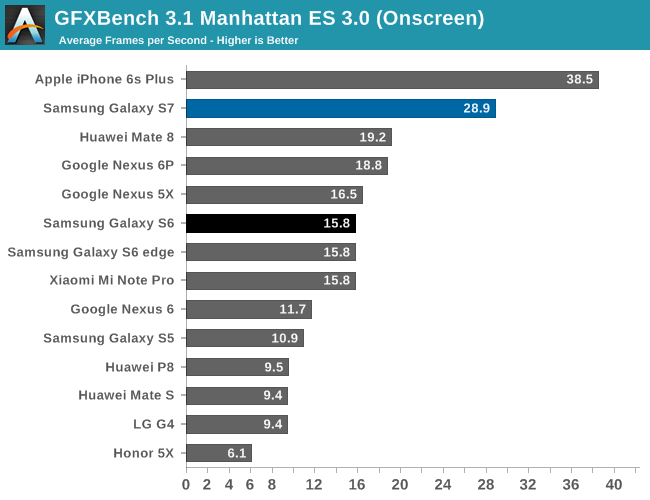

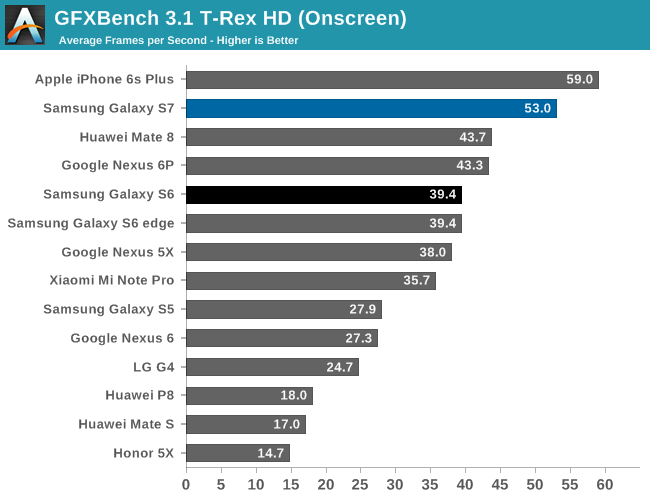
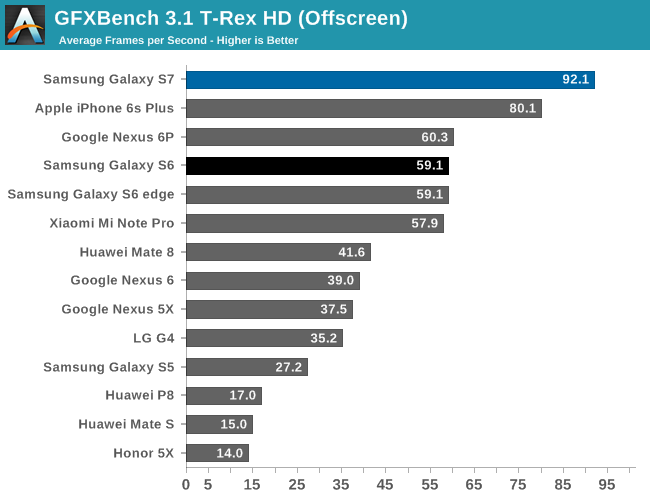
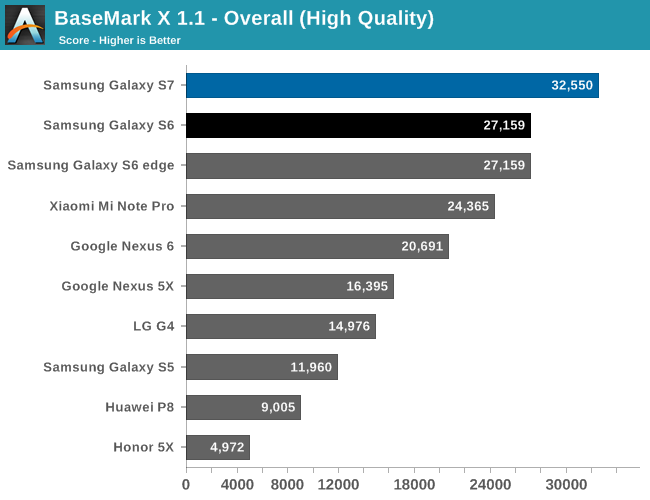

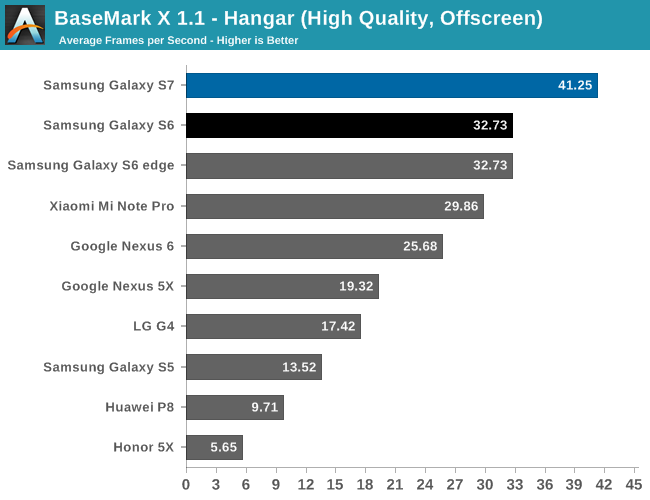
At a high level, GPU performance appears to be mostly unchanged when comparing the Galaxy S7 to the Snapdragon 820 MDP. Performance in general is quite favorable assuming that the render resolution doesn't exceed 2560x1440.
Overall, the Adreno 530 is clearly one of the best GPUs you can get in a mobile device today. The Kirin 950's GPU really falls short in comparison. One could argue that turbo frequencies in a GPU don't make a lot of sense, but given that mobile gaming workloads can be quite bursty in nature and that gaming sessions tend to be quite short I would argue that having a GPU that can achieve significant levels of overdrive performance makes a lot of sense. The A9 is comparable if you consider the resolution of iOS devices, but when looking at the off-screen results the Adreno 530 pulls away. Of course, the real question now is how the Adreno 530 compares to the Exynos 8890's GPU in the international Galaxy S7, but that's a question that will have to be left for another day.










202 Comments
View All Comments
fanofanand - Tuesday, March 8, 2016 - link
I have to agree with this assessment, I won't buy another phone without an IR blaster. I have 3 kids, and the remotes are ALWAYS missing.iheresss - Tuesday, March 8, 2016 - link
There is no such thing as 'shot noise'. Every digital noise is just lack of light to hit sensor. By having larger pixel size means larger area for light to hit photo sensor hence reduce the 'sensor noise'.ah06 - Tuesday, March 8, 2016 - link
But unless the total size of the sensor is increased, isn't increasing the pixel size making only a minor difference?A 1/2.5" sensor is only going to collect X amount of light whether it collects it over 16 million 1.1 um pixels or 12 million 1.4 um pixels.
The only (very slight) gain over the higher pixel count is the loss at pixel boundaries due to pixel pitch.
Am I wrong?
frostyfiredude - Tuesday, March 8, 2016 - link
Because the sensing area is larger per pixel, the number of photons incident in each pixel will increase with it. Those incident photons are what give the picture data. So weird quantum effects that somewhat simulate adding or removing photons have less significance when there are more photons to begin with.More specifically at 1.1um vs 1.4um, 1.1um being quite comparable to the wavelength of visible light is causing some extra anomalous effects too.
ah06 - Wednesday, March 9, 2016 - link
Yea I knew 1.1 um was the bare minimum due to quantam effects. But say going from 1.4 um to 2.0 um, would that make much of a difference?After all the total amount of light collected by the sensor would be roughly same right?
A flower can be composed of 10 million pixels of size X or 5 million pixels of size 2X, the total area of the flow will still have collected the same light?
Where am I going wrong with this :P?
arayoflight - Tuesday, March 8, 2016 - link
Actually no. The sensor on s7 is a 4:3 1/2.5" sensor while the one in s6 us a 16:9 1/2.6" one.What it means is that it collects about 21.49% more licht than the one on s6.
ah06 - Wednesday, March 9, 2016 - link
You're right about the aspect ratio difference, hope more reviewers cover that there is no "Real" loss of resolution .However, does increasing pixel size really affect total light collected by sensor?
jospoortvliet - Friday, March 11, 2016 - link
I don't think it does, but it decreases noise caused by chance: with smaller pixels you have noise in low light situations in part simply due to the chance of one pixel catching randomly a bit more licht fotons than correctly represented the scene, and another less. With bigger pixels you smooth that out a bit and thus less random noise. It is only ONE source of noise, but it helps.Just imagine you take a pic of the same scene with two sensors, one so small it catches 5 photons average per pixel cell, the other one is twice as big and catches, on average, 10. A random one photon difference in a given pixel cell gives 20% brighter or darker pixels on the small, 5 photon-catching sensor and only 10% on the bigger one.
Again, it is only one source of random noise, but a pretty fundamental one you can hardly calculate your way out off.
adamto - Tuesday, March 8, 2016 - link
@Joshua Ho. Do you mind if I ask favor? Does S7 support AC tethering? Do you now any other Android phone with AC tethering? I am not talking about connecting S7 phone to a 5Ghz wifi such as home internet. These days most phone can connect to 5GHz wifi anyway. What I am asking is. If S7 itself can become a 5Ghz WiFi hotspot. This is can be very useful feature for me for transferring files between connected device to S7 tethering. I appreciate if you share with us a screenshot of network connection speed at PC to the S7 tethering at second part of review. Thanks!nerd1 - Tuesday, March 8, 2016 - link
Web browsing bench using chrome AGAIN????? How many times have anandtech been criticized for this?